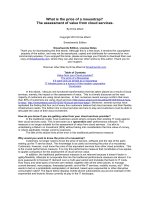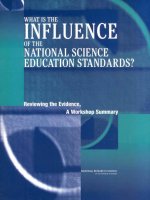What could the school of 2050 look like?
Bạn đang xem bản rút gọn của tài liệu. Xem và tải ngay bản đầy đủ của tài liệu tại đây (35.33 KB, 4 trang )
What could the school of 2050 look like?
From learning in the metaverse to streamlining administrative tasks, here’s our vision of education in
2050.
First, we had blackboards and chalk. Then whiteboards and dry-wipe pens. Overhead projectors and
acetate. Now we have interactive whiteboards. From hefty cathode-ray televisions that were wheeled
between classrooms, to flatscreen do-it-all screens, the classroom environment has kept pace with new
technologies. So too will the classroom of the future. We’ve come a long way since the 90s. And pretty
soon, we’ll be in the 50s.
So, what could the school of the future look like?
Undoubtedly, the biggest development we’ve seen in recent years has been advancing technology, so we
can be fairly certain that it will continue to play a significant role in the future. Whereas the traditional
model of education has remained largely unchanged for the past 100 or so years – pupils are divided by
age and the curriculum broken down into subjects – it has been adapted to incorporate new
technologies, as well as responding to economic, social, and political changes. Not to mention pandemicrelated upheaval.
It's unlikely this tried-and-tested model will change drastically over the next 25 or so years, but rather it
will adapt to our evolving world.
In 2050, net-zero deadlines will be upon us, and green technology will be comfortably embedded into
the classrooms. Recycling will be second nature and there will be no single-use plastics anywhere in
schools or universities. Some schools may have gone one step further, with student-grown vertical farms
as both a teaching aid and a sustainable resource for the local community.
Technology-driven leaps forward in education will have been gradual and practical. Rather than a
complete technological takeover of the classroom rendering schools (almost) unrecognizable,
improvement in current technologies and a sustained effort in emerging trends will be the order of the
day, with more accessibility and more information available at our fingertips.
And the way we access this information will change. From online learning platforms to more
personalized learning experiences alongside the incorporation of virtual and augmented reality, we may
see a shift towards a more interactive method of learning. To better prepare students for the workplace,
there may be greater emphasis on collaboration and problem-solving, rather than traditional lecturebased, note-taking teaching methods.
Here are a few ways that the school of 2050 may look different.
The classroom environment
On entering the classroom, biometric scanning will allow students to check in, streamlining the hustle
and bustle of registration. Teachers will be able to collate attendance data automatically, populate
perfect attendance records, and more easily track patterns of tardiness.
For the school of the future, there will be no need to wrestle with heavy curtains or dust-covered blinds;
we’ll have smart glass. Windows that can automatically adjust their tint to compensate for external
brightness, protecting both our eyes and screens.
As summer temperatures continue to rise – the general trend for 2050 being warmer, drier summers as
well as warmer, wetter winters – air-conditioned classrooms will become the norm. But they will be
cleaner, more efficient, and sustainable, with built-in air purifiers to remove toxins and dust from the air.
By 2050, 3D printers will have become a standard appliance, both in the home and at school. As a
learning aid, they will become essential, allowing teachers more flexibility to explain difficult concepts.
Students will be able to physically manipulate objects for better information processing, visual
perception, and cognitive learning. The structure of an eye? Easy. Exploring archaeological artifacts
without risk of damage? No problem. Understanding the now-antique internal combustion engine? That
too.
Augmented reality and AI
Adaptive learning systems driven by artificial Intelligence (AI) will have become integrated into the
school environment by 2050. Personalized learning experiences will take into account learning styles and
create adaptive assessments that adjust in real time based on performance.
AI may also be used to analyze pupils' work, even so far as predicting future performance, helping
teachers understand which students need more guidance on a particular concept before they fall behind.
Students will be able to get immediate feedback, with suggested areas for improvement and more
personalized tutoring, tailoring to a student’s strengths and weaknesses. This isn’t a new concept,
Intelligent Tutoring Systems (ITS) have been proposed for decades, but AI will make it considerably
easier.
The move towards more immersive and interactive learning experiences will also be facilitated by the
application of augmented reality and advances in AI. Interactive whiteboards will be kitted out with
augmented reality – where virtual objects are superimposed onto the real world – which will be
particularly useful for STEM subjects, allowing students to digitally dissect the human brain, analyze
chemical compounds in the clouds of Jupiter, or make size comparisons of dinosaurs.
But with AI has become more widely accessible – like the recently launched ChatGPT which can generate
sophisticated paragraphs of writing from prompts – so too will new plagiarism detection software. Sorry,
students.
The Internet, accessibility and remote learning
The pandemic has brought remote learning into the limelight. With a global population predicted to
reach 9.8 billion by 2050, and around 90 percent expected to have internet by then, it’s possible that
classrooms will be shared virtually with external pupils, providing learning to home students and
allowing for larger class sizes.
And with more pupils, teachers will have come to rely on AI automation of certain aspects
(administrative tasks like registrations and tracking grades), to ensure the best possible service, allowing
them to focus on teaching.
So it’s very unlikely that the internet itself will disappear by 2050. But it will change. We’re already
seeing hard drive storage replaced by virtual clouds; in-progress documents accessible from multiple
devices and from any location, and it’s likely this trend toward greater connectivity will continue. 5G will
be a thing of the past, but high-speed networks are here to stay, and we can expect to see more dataintensive applications and services as time goes on.
The use of Internet of Things technology will be widespread, with more devices and appliances
connected to the Internet, enabling greater automation and control over the school environment.
Outside the classroom, for example, you might encounter robot cleaners tidying the halls while lessons
are in session.
With a few exceptions, homework assignments will mostly be online. From downloading the assignment
at the end of the lesson to submitting it remotely (as many do now), students will be able to view their
coursework, see the percentage completed, and track overall assessments.
Instant notifications will alert pupils to deadline extensions, feedback, and grades. Parents and teachers
will be able to track progress, addressing issues as and when they arise.
Learning in the metaverse
And of course, with the internet comes social media. And by 2050, the Metaverse – a shared immersive
virtual space, where we can be free of our bodies, inhabiting our own digital avatars – will be well
established.
Wouldn’t it be great to try clothes in the metaverse and have the physical product shipped to us in the
real world? If the Metaverse comes to fruition, it will undoubtedly be a game-changer for online
shopping, but what about education?
Virtual and augmented reality technology will likely be advanced enough to create a sufficiently
immersive and interactive learning environment, perhaps even linked in with the real world; a teacher’s
physical words and movements translate seamlessly to their avatar.
But as more personal information is shared online, and we spend more time in the Metaverse, there will
be a greater emphasis on protecting a user’s security and privacy. We may even see cybersecurity
modules being incorporated into some subjects.
Of course, schools aren’t solely for educational development; they’re for social and emotional
development, too. In that respect, it’s unlikely the metaverse will completely replace the real-world
setting. Instead, it will supplement it to allow access to global educational resources and facilitate
interactions with exchange students from other schools.
Literature
Just like Captain Jean Luc Picard likes to settle down with an old leather-bound copy of Herman Melville’s
Moby Dick in the 24th Century, physical libraries will still exist in the mid-21st Century.
AR books will be common, but just as Kindle and e-books have exploded in popularity over the last
decade or so, access to reading material will become easier. Gone will be the days of lugging heavy
textbooks around, hastily cramming them into lockers after lessons.
Students of the future can look forward to having recommended reading materials right at their
fingertips, via e-readers and tablet devices which can be digitally annotated, or manipulated via VR.
We can already do this with today’s e-ink devices, and since tablets have been introduced as an integral
learning device in the last decade, studies have shown that they can motivate both pupils and teachers,
emphasizing interactivity and keeping them engaged with the content for longer.
By extension, digital literacy will be improved, and kids of the future will be even more tech-savvy than
your toddler who already knows how to buy Fortnite skins.
Subsequently, reliance on paper products will be reduced, although not eliminated completely. Artists
have been using paper for thousands of years, so it’s unlikely we’ll ever see its complete disappearance,
especially in art and design subjects. The paper we do use, however, will be eco-friendly; either recycled
or made from fast-growing plants like bamboo.









